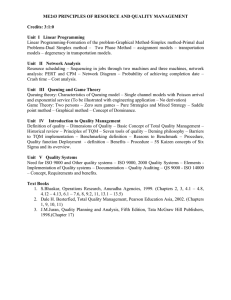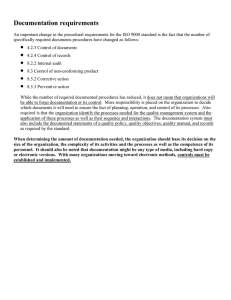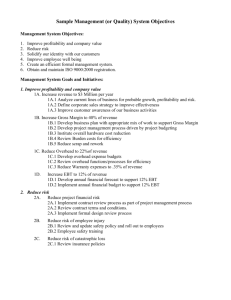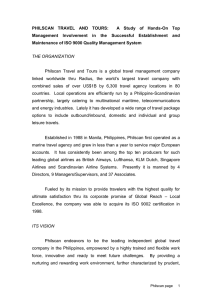THE BENEFITS OF THE IMPLEMENTATION OF THE ISO 9000
advertisement
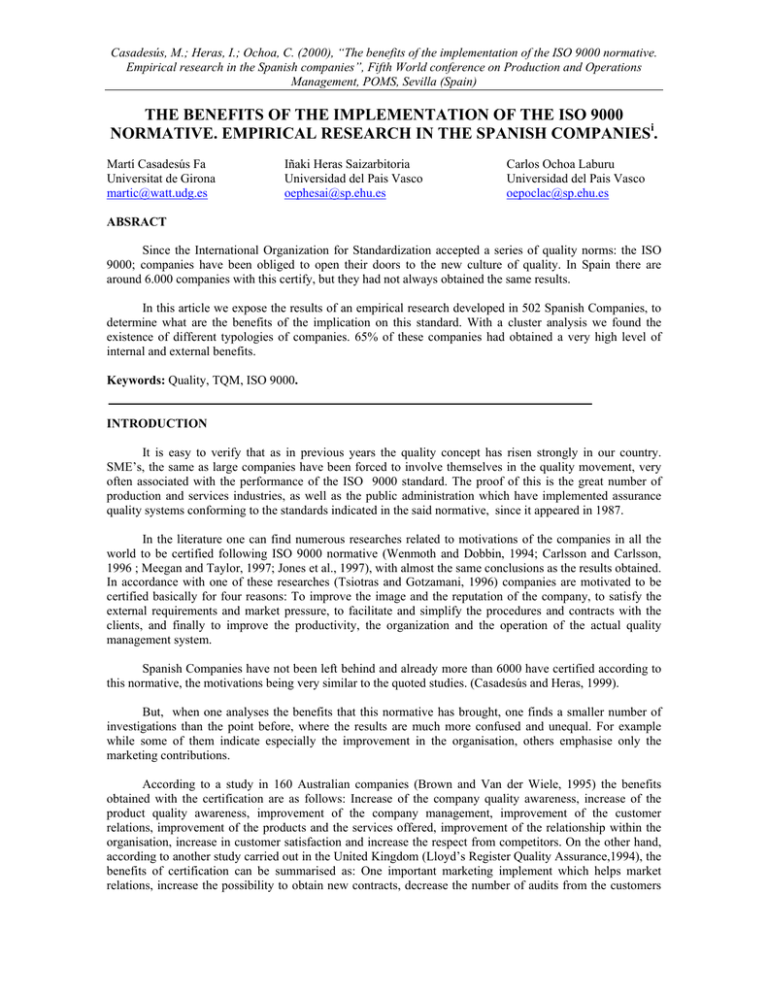
Casadesús, M.; Heras, I.; Ochoa, C. (2000), “The benefits of the implementation of the ISO 9000 normative. Empirical research in the Spanish companies”, Fifth World conference on Production and Operations Management, POMS, Sevilla (Spain) THE BENEFITS OF THE IMPLEMENTATION OF THE ISO 9000 NORMATIVE. EMPIRICAL RESEARCH IN THE SPANISH COMPANIESi. Martí Casadesús Fa Universitat de Girona martic@watt.udg.es Iñaki Heras Saizarbitoria Universidad del Pais Vasco oephesai@sp.ehu.es Carlos Ochoa Laburu Universidad del Pais Vasco oepoclac@sp.ehu.es ABSRACT Since the International Organization for Standardization accepted a series of quality norms: the ISO 9000; companies have been obliged to open their doors to the new culture of quality. In Spain there are around 6.000 companies with this certify, but they had not always obtained the same results. In this article we expose the results of an empirical research developed in 502 Spanish Companies, to determine what are the benefits of the implication on this standard. With a cluster analysis we found the existence of different typologies of companies. 65% of these companies had obtained a very high level of internal and external benefits. Keywords: Quality, TQM, ISO 9000. INTRODUCTION It is easy to verify that as in previous years the quality concept has risen strongly in our country. SME’s, the same as large companies have been forced to involve themselves in the quality movement, very often associated with the performance of the ISO 9000 standard. The proof of this is the great number of production and services industries, as well as the public administration which have implemented assurance quality systems conforming to the standards indicated in the said normative, since it appeared in 1987. In the literature one can find numerous researches related to motivations of the companies in all the world to be certified following ISO 9000 normative (Wenmoth and Dobbin, 1994; Carlsson and Carlsson, 1996 ; Meegan and Taylor, 1997; Jones et al., 1997), with almost the same conclusions as the results obtained. In accordance with one of these researches (Tsiotras and Gotzamani, 1996) companies are motivated to be certified basically for four reasons: To improve the image and the reputation of the company, to satisfy the external requirements and market pressure, to facilitate and simplify the procedures and contracts with the clients, and finally to improve the productivity, the organization and the operation of the actual quality management system. Spanish Companies have not been left behind and already more than 6000 have certified according to this normative, the motivations being very similar to the quoted studies. (Casadesús and Heras, 1999). But, when one analyses the benefits that this normative has brought, one finds a smaller number of investigations than the point before, where the results are much more confused and unequal. For example while some of them indicate especially the improvement in the organisation, others emphasise only the marketing contributions. According to a study in 160 Australian companies (Brown and Van der Wiele, 1995) the benefits obtained with the certification are as follows: Increase of the company quality awareness, increase of the product quality awareness, improvement of the company management, improvement of the customer relations, improvement of the products and the services offered, improvement of the relationship within the organisation, increase in customer satisfaction and increase the respect from competitors. On the other hand, according to another study carried out in the United Kingdom (Lloyd’s Register Quality Assurance,1994), the benefits of certification can be summarised as: One important marketing implement which helps market relations, increase the possibility to obtain new contracts, decrease the number of audits from the customers Casadesús, M.; Heras, I.; Ochoa, C. (2000), “The benefits of the implementation of the ISO 9000 normative. Empirical research in the Spanish companies”, Fifth World conference on Production and Operations Management, POMS, Sevilla (Spain) and considerably help to enter international markets. Obviously one can consider an important bias on the results of this study, because the above organisation is directly involved in the application of the normative. But, one can also find another study of another important consulting company (Vanguard Consulting, 1994), in which they confirm that only 15% of the companies obtained the benefits that the British Standards Institution set. The high dispersion of the existing results relating to the benefits of the implementation of the ISO 9000 normative, is why we ask ourselves what have the companies really obtained with the certification, especially in Spanish companies, analysing if is possible to define different typologies of companies which characterise the performances obtained. EMPIRICAL RESEARCH At the beginning of 1998 there was in Spain 4516 certified companies, which rose to 6412 at the end of the year. Due to the vast number of companies and the difficulties connected with undertaking a study of similar characteristics, it was decided to take a small sample of companies. For this study all the certified companies in Catalonia since 1998 and in the Vasc Country were selected, being 1570 companies in all sectors of activity. This sample was chosen because of being two of the communities with a higher number of certified companies and with a larger diversification of activities. Although we are investigating a limited area, this allows us to conduct a more in-depth study. On the other hand the backing of the “Centre Català de la Qualitat” of the Regional Government of Catalonia, enables us to carry out an exhaustive study. In this article and from the data obtained, it is possible to analyse what are the benefits obtained by the ISO 9000 certified companies. To do this, firstly we undertook a descriptive analysis and secondly a cluster analysis to determine if is possible to detect different typologies of companies in the sample. The companies included in each typology must have very similar characteristics, and distinct differences with the companies in the other typologies. PROFILE OF THE SAMPLE In this empirical work carried out, 502 valid responses were received (32%) of the 1570 companies which formed part of the initial sample. The characteristics of the sample used in the study are indicated by the following points: • Number of workers: Although at the outset the companies certified were large organisations with more than 300 employees (20% of the total), little by little more smaller companies have sought to obtain the ISO 9000 certification. In fact, the largest group of certified companies contain between 15 and 100 workers (38%), while the companies in the second group employ between 101 and 200 workers (28%). 8% of the certified companies has between 201 and 300 employees. It is important to emphasise that 6% of the certified companies has less than 15 employees, some of then with only 3 o 4 workers. • Economic sector: In the investigation we observe that although initially the normative ISO 9000 had an important effect on manufacturing companies, during the last years many service industries had been certified: it represents 31% in this sample. • Certifying Organisation: In the study carried out 57% of the companies had been certified by AENOR (Asociación Española de Normalización y Certificación), 16% by Bureau Veritas Quality International, 10% by LGAI (Laboratori General d’Assaigs i Investigacions) and the rest, in minimal percentages, by LRQA Limited, Lloyd’s Register, TÜV Product Service, Det Norske Veritas (DNV), SGS ICS Ibérica AEIE and ECA. Studying the selection of one organisation or another, it was noted that more than 60% of the cases had been for one of two reasons, being the reputation of the certifying organisation or for its recognition in its field. In this way it is demonstrated not only the necessity of the companies to comply with certain basic quality Casadesús, M.; Heras, I.; Ochoa, C. (2000), “The benefits of the implementation of the ISO 9000 normative. Empirical research in the Spanish companies”, Fifth World conference on Production and Operations Management, POMS, Sevilla (Spain) standards, but also showing the need to use the certification as a marketing tool giving advantages over their competitors. • External consultants: More than 80% of the companies had use the services of the consultants at some stage during the implementation. In 41% of the cases, companies had sought the help of an external consultant due to a lack of experience and a shortcoming of knowledge in quality management. The consultants were used for information and training in 35% of the cases, for coordinating the implementation of the system in 30 % of the cases and for designing the quality manual in 17% of the cases. It’s clear that in only 14% of the cases the consultants’ design of the procedures manual was used, because they were unaware of the particular work processes of each company. BENEFITS OF THE IMPLEMENTATION OF ISO 9000 Unfortunately some of the benefits derived from the ISO 9000 certification are unclear (for example the efficiency or the wellbeing of the company’s culture), whilst others can have different interpretations or measuring problems (for example the rise in productivity or the increase in market share) (Jones et al., 1997). Even so the difficulties in quantifying and measuring the said benefits, it is possible to separate between “internal” and “external” aspects of the company (Tsiotras and Gotzamandi, 1996). This differentiation is used in this investigation, as well as in others studies of similar characteristics (Lloyd’s Register Quality Assurance Ltd.,1994; Vloegeberhgs and Bellen, 1996). Other investigations, such as, Mo and Chan (1997) only make references to internal benefits. Studying the importance of the internal benefits related to the external, we encountered distinct opinions. Vloegeberhgs and Bellen (1996) state that the majority of the benefits obtained with the certification are of an internal nature. According to Brown et al. (1998), although the majority of the SMEs are certified for external reasons, the most important benefits are of an internal character: improvement of the awareness of the importance of quality, improvement of the awareness of the problems of the company, and improvement of the product quality. On the other hand Quazi and Padijbo (1998) state that the most important benefits are of an external nature, the three most important being: increase in customer satisfaction, improvement of the product quality and competitiveness in the market and satisfying customers requirements. It is not the object of this investigation to ascertain which benefits are more significant, external or internal, only to understand which they are. This approach is used only for practical purposes, facilitating the understanding of the results obtained. Internal benefits analysis The empirical evidence analysed shows that the most important internal benefits of the application of the normative are as follows: Improvement of the definition and standardisation of the work procedures (33%), improvement in the definition of the responsibilities and obligations of the workers (19%), increase in the company quality confidence (11%), better involvement in work (11%) and improvement in guidelines thus reducing improvisation (7%). All other aspects were deemed of minor importance. These results are similar, with some exceptions, to other research on the internal benefits of the normative. For example, in an investigation of special relevance carried out in 1.220 companies, Buttle (1997) noted that the most important internal benefits are: Improvement in efficiency, improvement in work procedures, improvement in management and control of the company, decrease of problems with procedures and increase in the motivation of the workers. After observing how the two most important benefits are directly related to the correct internal organisation of the company, it appears to confirm that which Havm et al. (1997) suggested as a pre-requisite for a successful adoption of the ISO 9000: to advance with a reengineering process. Another important contribution of the normative is the use of the data collected by the system for strategic and/or operational purposes. In 95% of the companies this data is used, contradicting the study by Casadesús, M.; Heras, I.; Ochoa, C. (2000), “The benefits of the implementation of the ISO 9000 normative. Empirical research in the Spanish companies”, Fifth World conference on Production and Operations Management, POMS, Sevilla (Spain) Goh and Ridgway (1994) where the majority of companies did not see any advantage in analysing this quality cost. Analysing the changes introduced regarding human resources management of the company (graph I), it is proved that there are two aspects in which the certification has quite positive effects: Improvement in job satisfaction and improvement in communication between management and employees. The normative has very little influence in the lowering of employee absenteeism. However it could be argued that there is no case where the normative has negative effects in any of the aspects analysed. 100% 90% Percentage 80% 70% 60% 50% 40% 30% 20% 10% 0% Work satisfaction Suggestion system Positive influence Health / Safety Neutral Turnover Absence Negative Influence Graph I: Influence of the ISO 9000 certification on human resources management (Internal benefits) Regarding the internal management of the operations (graph II), the most positive aspect to have affected the normative is the considerable reduction in the errors and the defects produced during the manufacturing processes. We can also observe a considerable improvement in the management of the work orders and in the confidence that they are well executed. Others aspects in which the normative has had positive influence are: the possibility of improving the level of delivery-time, the consequential savings in production cost and finally the reduction of lead time. The only aspect in which the certification has been prejudicial to companies is a certain increase in the cost of quality management, based on the comments of 13% of the companies. On another hand, 60% of the companies argued exactly the opposite. The costs saved are very difficult to evaluate, although some consultants such as SGS Yarsley (1992), in a study in which 500 companies participated, stated that with these savings 90% of the companies recuperated their investment within 3 years (SGS Yarsley, 1992). To sum up, although at the outset the companies were motivated to be certified mainly for external reasons, as can be proved in practically every investigation (Carlsson and Carlsson, 1996; Jones et al. 1997; Mo and Chan, 1997; Lee, 1998), is clear that the internal consequences are very important and in almost every case very positive. However, all those companies that have improved productivity substantially with the application of the normative have to take into account that this is not only caused by the normative, also markedly by the implementation of it and the method of carrying it out. That is why the work is still not finished, but just beginning. To define the normative and to include it in the work process is essential, but once it is done, the real productivity improvements will arrive with the scientific organisation of work, analysing the tasks and combining each one of the simple operations to arrive at the final product. Casadesús, M.; Heras, I.; Ochoa, C. (2000), “The benefits of the implementation of the ISO 9000 normative. Empirical research in the Spanish companies”, Fifth World conference on Production and Operations Management, POMS, Sevilla (Spain) 100% Percentage 80% 60% 40% 20% 0% Errors and defects Order processing Reliability Positive influence Costs Neutral On-time delivery Cost savings Lead time Stock rotation Negative influence Graph II: Influence of the ISO 9000 certification on operations management (Internal benefits) External benefits analysis In this investigation, the most important external benefits of the implementation of the ISO 9000 are: The response of the clients’ requirements (34%), access into new markets (21%), improvement in customer relations (18%), improvement in services to customers (16%) and minimising customer audits (8%). One can prove the great commercial importance and quality image offered by the normative, because none of the three foregoing benefits is related to a real improvement in quality. 100% 90% Percentage 80% 70% 60% 50% 40% 30% 20% 10% 0% Customer satisfaction Positive influence Complaints Repeat purchases Neutral Negative influence Graph III: Influence of the ISO certification on the external customers (External benefits) In respect of the influence of the normative in the aspects related to external customers of the company, three points are emphasised (graph 3): The increase in customer satisfaction, the decrease in the number of complaints, the rise in repeat purchasing by the customers. We emphasise that in the first aspect there is virtual unanimity in all the companies consulted. It must be said that one of the motivations why many companies certified is precisely at the request of the customers (Jones et al. 1997). Later this proved to be a benefit, even more than the real improvements of the products and services. The objective has been realised. With the normative the company obtains the increase in quality image that it seeks, although sometimes the real improvement is not very relevant. Casadesús, M.; Heras, I.; Ochoa, C. (2000), “The benefits of the implementation of the ISO 9000 normative. Empirical research in the Spanish companies”, Fifth World conference on Production and Operations Management, POMS, Sevilla (Spain) On the another hand, one observes that in practically no case did the certification have a negative effect in any of the aspects related to external customers of the company, as was shown in the previous internal benefits. There is only dissatisfaction in some customers due to excessive documentation laid down by the system, especially before the first revision of the procedures of the quality system. These results coincide with others investigations (Lloyds Register Quality Assurance, 1994). With regard to the collecting of the client data ( the basic requirement to carried out a good quality management) only in 33% of the cases did the companies undertake this annually, 16% every 3 months, 40% without any set timing and 11% never. Probably this weakness of the system, which had already been discovered in other investigations (Goh and Ridgway, 1994), will be overcome with the new normative ISO 9000:2000 process orientated, with especially attention to the continuous improvement and the total satisfaction of the customers. 100% 90% 80% Percentage 70% 60% 50% 40% 30% 20% 10% 0% Market share Sales per employee Positive influence Neutral Return on sales Return on assets Negative influence Graph IV: Influence of the ISO 9000 on the financial aspects (External benefits) Another benefit of the certification is the influence on the financial aspects of the company (graph IV). 58% of the cases considered that the normative had allowed considerable increase in market share, as well as increase in the upward trend of sales of the company. On the other hand, the majority of companies did not see a considerable increase in the rate of sales per employee, nor in the return of investments. However, in the cases where certification had influence in some form, it was always positive, that is to say, improving the foregoing aspects. In general the results obtained resemble those of Lloyds Register Quality Assurance Ltd (1994) where it was confirmed that in 49% of the cases the companies had benefited from the certification due to the increase in the market share obtained. It must be emphasised that in a later more detailed analysis of the internal and external benefits of the companies related to the time that the certificate was operative, there were no significant differences between those who were certified recently and the companies with the certification more than three years old (first revision). This appears to confirm the lack of improvements in the companies after a given period of time, the same as has been noted in other investigations (Jones et al.,1997). This contradicts the results of the majority of the surveys of the organisations involved in quality management (Lloyd’s Register Quality Assurance Ltd.,1994). COMPANIES’ TYPOLOGIES DEPENDING ON THE BENEFITS OF IMPLEMENTING ISO 9000 Casadesús, M.; Heras, I.; Ochoa, C. (2000), “The benefits of the implementation of the ISO 9000 normative. Empirical research in the Spanish companies”, Fifth World conference on Production and Operations Management, POMS, Sevilla (Spain) To study if is possible to describe different typologies of companies in the two studied aspects, internal and external benefits of the certification ISO 9000, we carried out a cluster analysis. In this we have included all the studied variables, although in this article we only present the most relevant ones. To work with all types of variables (continuous, discretes and binaries), it is not adequate to use the matrices with standard distances of the most common statistical software (SPSS o Minitab), as well as to calculate any previous principal components. Initially we design a matrix of distances which reflects similarities and differences between companies, based on the directives of Everitt (1993), to finally reach a cluster analysis. On the other hand, for both aspects studied we design a graph of the studied referring to three representative variables, although this does not imply that they are the most important or outstanding. Each variable is represented by an axis from 0, when the said variable has minimal effect, increasing to 100 when the said variable has maximum effect. The different typologies of companies or clusters are represented by a sphere whose co-ordinates are the middle of the three variables of the companies which form part of it and with a volume proportional to the number of companies within the cluster. In this way, with this fictitious graph, we could give a clear sight of the differences and similarities between the different typologies studied, and the number of companies which form part of each one. There has been no evidence in literature of any investigation of similar characteristics, so it will not be possible to compare the obtained results to others. Companies’ typologies depending on internal benefits When we analyse the variables in relation to the internal benefits of the implementation of the ISO 9000 normative, we discover two typologies of different companies which we have named: “HIB+” (Companies with high internal benefits) and “MIB-”(Companies with moderate benefits). Saving costs HIB + (Companies with high internal Improvem ent on the work satisfacti benefits) MIB - (Companies with moderated internal benefits) Satisfaction with the collaboration of Graph V: Typologies of companies depending on internal benefits • HIB + : This first cluster, formed by 79% of the companies, is principally constituted by the companies most satisfied with the certification. Basically there are companies which are certified with the ISO 9002 normative. 69 % of the companies in this group recognise the important Paper developed by the Public Administration in quality management. These companies are the ones that had improved most in the following: Work satisfaction in 78 % of cases, safety at work in 57%, communication between employees and managers in 73%, salary of the workers in 52%, decrease Casadesús, M.; Heras, I.; Ochoa, C. (2000), “The benefits of the implementation of the ISO 9000 normative. Empirical research in the Spanish companies”, Fifth World conference on Production and Operations Management, POMS, Sevilla (Spain) the quality costs in 78% and increase in stock rotation in 50%. Moreover, 74% of companies mentioned recognised a decrease in their costs with the application of the normative. 84% of the companies considered that the normative must be expanded particularly including environmental and safety at work aspects. • MIB - : The companies which form the second group, 21% of the total, are those which, although satisfied, have not obtained so many internal benefits with the application of the normative as those of the first group. 74% of the cases are companies certified under ISO 9001. They only recognised improvement in work satisfaction in 40% of them, improvement on the suggestions procedures in 49%, improvement in the personal gains of the workers in 20% and improvement in the level of rotation of stock in 17%. Only in 14% of the cases was it considered a saving in costs, while 29% confirmed that they had increased costs. Only 37% of the companies of this group valued positively the apportion of the Public Administration on Quality Management. Companies’ typologies depending on external benefits Also in the analysis undertaken regarding the external benefits of the implementation of the ISO 9000 normative, two typologies are emphasised, named “HEB+” (Companies with High External Benefits) and “LEB-” (Companies with Low External Benefits), with some percentages very similar to those mentioned before: 71 % of the companies formed part of the group more satisfied with the external benefits of the certification and 29 % belongs to the other group. Decreasing of complaints HEB + (Companies with high external benefits) LEB - (Companies with low external benefits) Increasing of the sales Improving the customers Graph VI: Typologies of companies depending on external benefits • HEB + : The companies which form part of this group are those most satisfied with the external benefits of the normative. With the certification, 95 % of the cases obtained improved client satisfaction, decrease in the number of complaints in 86 %, improvement in repeat business in 75% of the cases, 82% increase in the market share, improvement in the ratio of sales per employee in 68%, improvement in ROI in 95% and definitively increase in the level of sales in 80 % of the cases. These companies, which in 99 % of the cases greatly recognise the benefits of certification, value much more the importance of the quality management than before. Moreover, in 71% of them value positively the collaboration of the Public Administration in the improvement of the quality. • LEB - : The companies which form part of this second group are those that have benefited less externally by the ISO 9000 certification. Only 38% of this companies value positively the contribution of the Public Administration during the certification. As a result, only 45% of these Casadesús, M.; Heras, I.; Ochoa, C. (2000), “The benefits of the implementation of the ISO 9000 normative. Empirical research in the Spanish companies”, Fifth World conference on Production and Operations Management, POMS, Sevilla (Spain) cases have reduced the number of complaints, only 17% has increased the market share and level of repeat business, 2% has improved the return on investment and 13% has increased sales. Definitively, the results of the analysis of the internal and external benefits of the ISO 9000 certification lead us to reach parallel conclusions. In both cases we determine two typologies of companies: A majority group of companies who had benefited most by the certification, and the other minority group who, although they also had obtained a certain level of improvement, the benefits were quite low. It is important to emphasise that in none of the two analyses carried out is it possible to observe any group of companies where the effects of the normative can be considered negative; too minimal to be considered significant. If we represent the four typologies in only one graph (graph VII), taking into account which companies form part of each typology, we clearly see that 65% of the companies have benefited considerably, internally and externally, by the ISO 9000 certification. On the other hand, 15% of the cases considered that the improvements had little relevance. The remaining 20% is divided between 14% of the companies who believe that they have obtained important internal improvements but not external ones, and 6% who consider just the opposite. CONCLUSIONS With this research we have described which are the benefits obtained thanks to the ISO 9000 certification in Spain, and at the same time we have defined the different typologies of companies resulting from the benefits of the said normative. To sum up, it is significant that 65 % of companies that benefited externally and internally by the normative, while 6% showed much lower benefits. Also it is important to comment that in 96 % of the cases studied the ISO 9000 normative is considered to be a good system of quality assurance, and that in 75 % of the cases studied it is believed that environmental aspects and health and safety standards must be included in the normative in the future. Now companies have the tendency themselves to implement these aspects into the quality system already existing. For this particular reason, and others, the committee of experts forming part of the International Organisation for Standardisation for quality had been working on the new ISO 9000:2000. This new release of the normative presents a structure focused on procedures, in which the continuous improvement and the measure of customer satisfaction has a very important role. The companies must be prepared to accept this challenge, including the ones forming part of the typology named as “most satisfied with the normative” as well as the “least satisfied” still interested in “quality culture”. 100% 80% 65% 60% 40% 20% 14% 6% MIB - HEB + External benefits HIB + 15% 0% LEB - Internal benefits Graph VII: Typologies of companies depending on the level of internal and external benefits. Casadesús, M.; Heras, I.; Ochoa, C. (2000), “The benefits of the implementation of the ISO 9000 normative. Empirical research in the Spanish companies”, Fifth World conference on Production and Operations Management, POMS, Sevilla (Spain) Without doubt, the process of certification following the ISO 9000 standard when well done, has represented an evolution in the way to manage a company: the organisation, the communication and the quality system in general are some of the keys of the success in the company management, as has been demonstrated. A cultural change has been necessary to alter the whole organisation, involving all the company, where the continuous improvement has been one of the basic tools for increasing the competitiveness of the companies, and the majority of the Spanish companies have profited. Finally, although there is a new release of the normative, the quality systems will continue be implemented within the company, for all workers, with the assistance of many experts when required. The quality and the improvement are an educational process and a continuous learning that create a benefit, sometimes difficult to quantify in a short time. The “quality movement” encourages employee involvement and leads to a continuous daily improvement, resulting in this added value being projected to the customers. REFERENCES BROWN, A. and VAN DER WIELE, T. (1995): "Industry experience with ISO 9000", Asia Pacific Journal of Quality Management, vol. 4, no. 2, 8-17. BROWN, A., VAN DER WIELE, T. and LOUGHTON, K. (1998): "Smaller enterprises’ experiences with ISO 9000, International Journal of Quality & Reliability Management, vol. 15, no. 3. BUTTLE, F. (1997): "ISO 9000: marketing motivations and benefits ", International Journal of Quality & Reliability Management, vol. 14, no. 9, 936-47. CARLSSON, D. and CARLSSON, M. (1996): "Experiences of implementing ISO 9000 in Swedish industry", International Journal of Quality, vol. 13, no. 7. CASADESÚS, M. and HERAS, I. (1999), “ISO 9000: Obstáculos y beneficios. Expectativas que se derivan de un estudio empírico reciente en 500 empresas españolas”, Foro de Calidad, no. 105, 42-7. EVERITT, B. S. (1993),: Cluster analysis, Edward Arnold, London GOH, P.L. and RIDGWAY, K. (1994), “The implementation of TQM in small and medium-sized manufacturing companies”, The TQM Magazine, vol. 6, no. 2, 54-60. HVAN, L., NIELSEN, A.P. and BJARNO O.C. (1997), “Re-engineering caused by ISO 9000 certification”, Business Process Management Journal, vol. 3, no. 3. JONES, R. , ARNDT, G. and KUSTIN, R. (1997), “ISO 9000 among Australian companies: impact of time and reasons for seeking certification on perceptions of benefits received”, International Journal of Quality & Reliability Management, vol. 14, no. 7. LEE, T. Y. (1998), “The development of ISO 9000 certification and the future of quality management. A survey of certified firms in Hong Kong”, International Journal of Quality & Reliability Management, vol. 15, o. 2, 162-6 LLOYDS REGISTER QUALITY ASSURANCE LTD (1994), BS 5750/ ISO 9000 - Setting Standards for Better Business, Lloyds Register Quality Assurance Services Ltd, Croyden. MEEGAN, S.T. and TAYLOR W.A. (1997), “Factors influencing a successful transition from ISO 9000 to TQM. The influence of understanding and motivation”, International Journal of Quality & Reliability Management, vol. 14, no. 2. MO, J. and CHAN, A. (1997),“Strategy for the successful implementation of ISO 9000 in small and medium manufacturers”, The TQM Magazine, vol. 9, no. 2, 135-45. QUAZI, H.A. and PADIB JO, S.R. (1998), “A journey towards total quality management through ISO 9000 certification. A study on small and medium sized enterprises in Singapore”, International Journal of Quality & Reliability Management, vol. 15, no. 5, 364-71. SGS YARSLEY(1992), Attitudes to BS 5750, SGS Yarsley, Camberley, Surrey. TSIOTRAS, G. and GOTZAMANI, K. (1996), “ISO 9000 as an entry key to TQM: the case of Greek industry”, International Journal of Quality, vol. 13, no. 4. VLOEBERGHS, D. and BELLENS, J. (1996), “Implementing the ISO 9000 standards”, Quality Progress, vol. 29, no. 6, 43-8. WENMOTH, B.A. and DOBBIN, D. (1994), “Experience with implementing ISO 9000”, Asia Pacific Journal of Quality Management, vol. 3, no. 3, 9-27. i Research work developed with the collaboration of the “Universidad del País Vasco” (UPV 054-263-HA021/99) , the “Diputación Foral de Gipuzkoa” and the “Centre Català de la Qualitat”.

